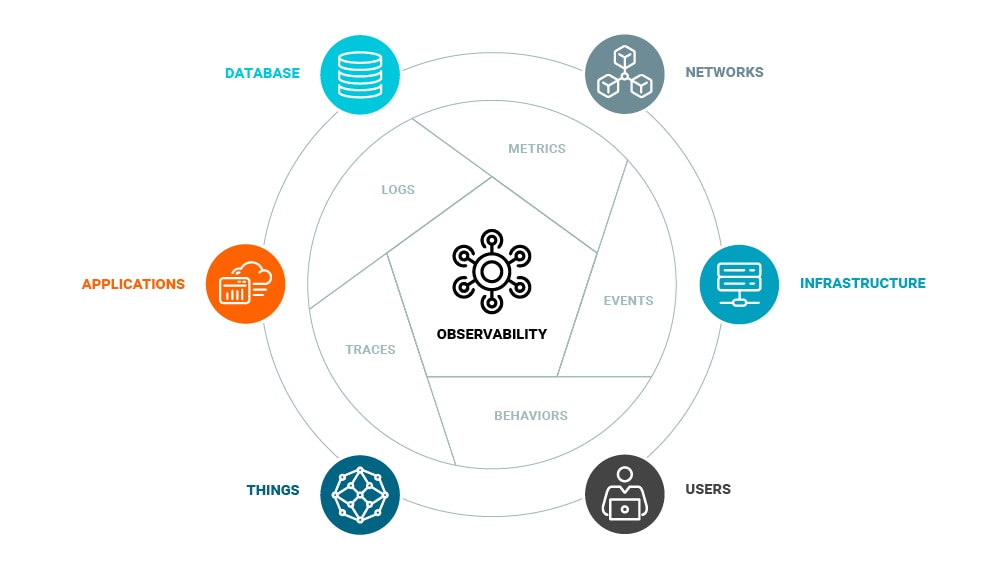In today's digital age, where technology plays a pivotal role in every aspect of our lives, ensuring the smooth and uninterrupted functioning of software applications and systems has become critical. This is where Observability shines. Observability is the ability to gain deep insights into the inner workings of a system, enabling organizations to identify and address issues before they turn into major disruptions. As organizations increasingly adopt hybrid cloud environments to fuel their growth, the need for full-stack Observability has become more critical than ever.
The shift towards hybrid cloud architecture has brought forth numerous benefits, combining the greater scalability and agility of public clouds like AWS or Azure while still enabling organizations to retain control over sensitive data in private data centers or colocation facilities. These benefits, however, do not come without a cost. As the dynamic nature of hybrid cloud environments adds additional layers of complexity to an IT infrastructure, it becomes more difficult to monitor with traditional approaches.
Defining Observability
Before diving into the advantages of Observability, we need to first understand what is Observability and distinguish it from monitoring. Traditional monitoring focuses on collecting and analyzing specific pre-defined metrics and logs to determine the health and performance of a system. Additionally, it may focus on different aspects or layers of the overall stack. Monitoring tools are ideal for helping IT teams understand the state of individual systems at a given time based on predefined metrics.
Observability, on the other hand, provides a comprehensive and more cohesive view of the entire IT environment so IT teams can diagnose the health of the entire technology ecosystem. For example, monitoring is akin to measuring a patient’s blood pressure or heart rate, while Observability would be more like a doctor analyzing those and other sets of information, such as cholesterol level, BMI, amount of activity, etc., to diagnose the patient’s overall health.

Observability becomes increasingly more important and necessary in the hybrid cloud world with a greater number of complex networks, more systems and devices, and more applications, along with microservices and containers. In such an environment, with multiple components interacting with each other, it becomes increasingly more difficult to identify the root causes of complex issues. Observability embraces this complexity by offering real-time visibility into every layer of the system, from infrastructure to applications, making it easier to diagnose the true health of a system.
Monitoring is necessary as it enables organizations to acquire detailed information about the health and behavior of individual components within the technology stack. Observability’s key advantage is its ability to provide more granular information about the behavior of individual components by enabling IT organizations to trace the flow of requests through multiple microservices and enabling the consumption of this information in a more holistic way where the interactions between multiple components are revealed. This enables engineers to gain greater insights into what is truly going on with systems under their purview and pinpoint the root cause of issues more quickly, reducing mean time to resolution and minimizing the impact on end-users.
Another benefit of Observability is its proactive nature. You are no longer constrained by the watermelon effect, where everything is green on the surface, while things are red underneath with unhappy users and service. Rather than waiting for users to report problems, Observability empowers organizations to detect anomalies and trends in real time. By setting up intelligent alerts and thresholds, teams can identify potential issues before they impact the user experience. Furthermore, Observability enables the analysis of historical data, helping organizations identify patterns and plan for future capacity needs.
Observability for the Hybrid IT
A full-stack Observability solution can provide numerous advantages to organizations in managing their hybrid IT environments consisting of both on-premises and public cloud infrastructures as well as SaaS applications delivered by third-party vendors.
1. Enhanced Visibility
Hybrid IT environments involve multiple interconnected components across different infrastructures. As a result, monitoring each aspect individually provides only fragmented insights. Full-stack Observability eliminates these silos by providing a holistic and comprehensive view of the entire ecosystem. With richer, more contextual data, IT teams can identify problems, such as network bottlenecks, more quickly, visualize correlations between different systems and services, and resolve issues more promptly.
2. Proactive Monitoring
Applications in hybrid infrastructures, by definition, are distributed across multiple environments – private data centers, self-hosted and managed in the public cloud, and SaaS applications managed by the vendor, to name a few. Deploying a full-stack Observability solution enables IT teams to proactively stay on top of all their applications, preempting any potential issues before they snowball into major incidents. By leveraging machine learning algorithms and AI-driven analytics provided by state-of-the-art Observability solutions like the ones from SolarWinds, IT teams can also gain predictive capabilities to anticipate problems and take preventive actions.
3. Tools Consolidation
Organizations have traditionally relied on a diverse set of best-of-breed products to manage different parts of their technology stack. As the complexity of managing the ever-increasing distribution of IT across hybrid environments has gone up, this strategy has led to tool sprawl, information silos, and alert fatigue, leading to higher costs and lower productivity. A full-stack Observability solution can help IT teams consolidate tools by providing a holistic view across IT Ops, DevOps, and CloudOps teams, and IT leadership. This single source of truth can help IT teams gain an understanding of the true state of their systems, identify issues faster, and improve service delivery, reliability, and developer productivity while reducing costs and risks.
4. Seamless Troubleshooting
Isolating the root cause of issues in a hybrid IT environment is often more challenging due to the sheer number of variables involved. With granular insights into all layers of the stack - from infrastructure components to application performance and beyond – a full-stack Observability solution equips IT teams with the tools and the information they need to pinpoint issues faster and minimize Mean Time to Resolution. With its integration with SolarWinds® Service Desk, as well as with other leading service desk solutions such as ServiceNow, full stack Observability from SolarWinds goes even further by automating and streamlining service and incident management all from a single solution.
5. Continuous Compliance
Hybrid IT environments bring forth new challenges regarding regulatory compliance and data governance. Full-stack Observability helps organizations ensure compliance across their infrastructure by monitoring and ensuring that all devices across the environment are configured properly and are in compliance with all security controls and protocols, providing alerts if there are any deviations, such as firmware vulnerabilities or policy violations. With Observability solutions from SolarWinds, you can ensure additional compliance through integration with our security solutions that help you track and enforce additional security protocols, such as tracking access logs and managing security related events.
Full-stack Monitoring and Observability from SolarWinds
Observability is essential in today's complex and dynamic IT landscape. It goes beyond traditional monitoring approaches by providing deep insights into the inner workings of systems and empowering organizations to address issues before they become disruptive. Monitoring and Observability Solutions from SolarWinds, SolarWinds® Hybrid Cloud Observability, our self-hosted solution, and SolarWinds Observability, our SaaS solution, offer a comprehensive set of tools to achieve full-stack Monitoring and Observability by connecting and correlating data across networks, infrastructure, applications, databases, and security. By leveraging SolarWinds solutions, organizations can ensure the smooth operation of their IT systems and deliver a seamless user experience.
This blog is the first in a series where we will explore the advantages of Monitoring and Observability solutions from SolarWinds. Keep a look out for the next blog in the series where we will explore Enhanced Visibility in more detail.








